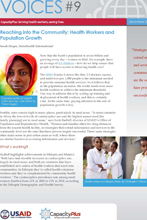
Increasing Access to Integrated Services: Scott Radloff on the Key Role of Health Workers
In the context of the global health worker shortage and the rapidly expanding population, getting health services to people in need is a persistent challenge. “Women and families often live long distances from the nearest health facility,” says Scott Radloff, director of USAID’s Office of Population and Reproductive Health, “so strategies that extend information and services to the community level are the ones that have proven largely successful.” In the latest edition of CapacityPlus Voices, “Reaching into the community: Health workers and population growth,” Radloff talks about strategies to bring health services to communities in need. He shares examples from Ethiopia and Malawi and highlights the key role of health workers who succeeded in bringing integrated services to rural populations and increasing the contraceptive prevalence rate.
In the latest edition of CapacityPlus Voices, “Reaching into the community: Health workers and population growth,” Radloff talks about strategies to bring health services to communities in need. He shares examples from Ethiopia and Malawi and highlights the key role of health workers who succeeded in bringing integrated services to rural populations and increasing the contraceptive prevalence rate.
Driven by increases in health workers that reach into the community, this approach has worked in a number of countries. Radloff notes that “these successes have not been limited to family planning and increased contraceptive use—this community approach has been successful in improving maternal and child health indicators as well.”
Bringing services to rural areas calls for creative measures, Radloff says, such as “introducing a new cadre of workers at the community level or finding innovative ways of reaching out beyond the facilities into the community.”
Related items:


